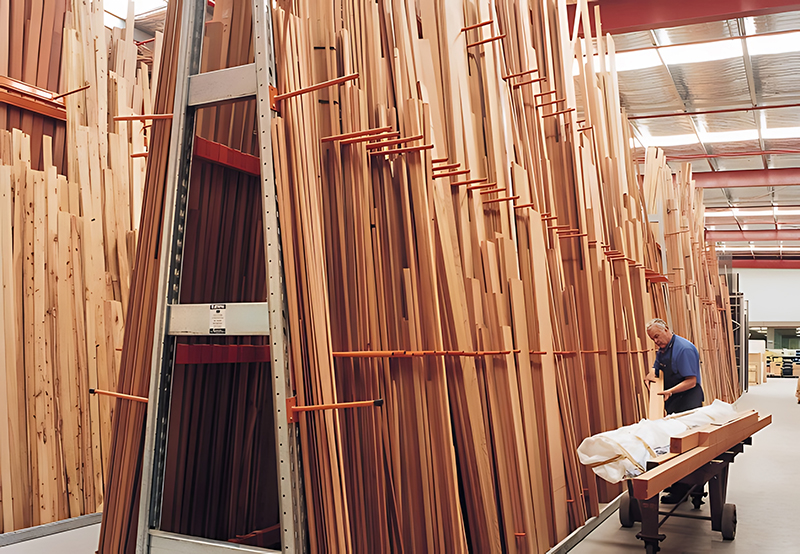Storing long materials like pipes and wood presents a universal challenge across industries such as construction, plumbing, and furniture manufacturing. Traditional horizontal stacking or cantilever racks often lead to bending, warping, and structural damage—problems that directly impact project timelines and material costs. Vertical storage shelves and vertical tube storage racks offer a transformative solution by addressing the root causes of deformation while optimizing space and workflow. Here’s how these systems work and why they’re indispensable for modern storage needs.
Why Pipes and Wood Deform in Traditional Storage
1. Uneven Pressure from Horizontal Stacking
2. Horizontal storage subjects materials to concentrated weight from layers above. For example, PVC pipes or wooden planks at the bottom of a stack bear the full load of upper layers, leading to bending over time. This issue is exacerbated with long-term storage, as gravity gradually distorts materials without proper support.Collision and Compression
3. Interlaced stacking in crowded warehouses increases friction and pressure between materials. Wooden beams stored horizontally often warp due to uneven humidity exposure, while steel pipes develop surface dents from accidental impacts during retrieval.Lack of Structural Support
Without mid-span support, lengthy materials sag under their own weight. For instance, untreated lumber left unsupported for months may develop permanent curvature, rendering it unusable for precision tasks like cabinetry.
Vertical Storage Solutions: Key Advantages
1. Eliminate Pressure with Vertical Orientation
2. Vertical storage shelves store pipes and wood upright, distributing weight evenly along their length. This prevents bending caused by horizontal stacking. BITO-Lagertechnik’s galvanized steel racks, for example, support up to 551 lbs (250 kg) per shelf2, ensuring heavy-duty materials like steel pipes remain straight and secure.Isolated Compartments Prevent Damage
3. Vertical tube storage racks use dividers to separate materials, minimizing contact and collision. The WINSOME WOOD system1 features adjustable shelves and high-gloss finishes, ideal for organizing wood planks by size while protecting surfaces from scratches.Enhanced Support Systems
Reinforced bases and anti-tilt designs ensure stability. BITO’s modular racks2, with a 72.8-inch (1,850 mm) height, include galvanized steel frames that resist corrosion—perfect for humid environments like woodworking shops or outdoor storage yards.
Design Features That Reduce Deformation Risks
● Adjustable Dividers: Customize spacing to match material dimensions. For example, acrylic vertical storage tube systems in labs prevent microplate warping by providing snug, labeled slots.
● Durable Materials: High-strength carbon steel or powder-coated finishes (like those in WINSOME WOOD’s espresso-colored shelves1) withstand heavy loads and environmental wear.
● Non-Slip Bases: Rubberized feet or textured surfaces keep racks stable, even on uneven floors.
Real-World Applications
1. Construction Sites
2. A U.S.-based contractor reduced PVC pipe waste by 40% after switching to vertical tube storage racks. By storing pipes upright in a BITO system2, they eliminated bending and accelerated on-site retrieval.Furniture Workshops
3. A Texas cabinetry studio uses WINSOME WOOD’s 29-inch-tall shelves1 to store oak planks vertically. This method prevents warping, ensuring wood stays flat and ready for precision cutting.Plumbing Supply Warehouses
Galvanized steel racks2 organize copper pipes by diameter, reducing handling time and minimizing surface scratches that could compromise installations.
Conclusion: Invest in Vertical Storage for Long-Term Savings
Vertical storage shelves and vertical tube storage racks are not just organizational tools—they’re strategic investments. By preventing material deformation, these systems reduce replacement costs, improve workplace safety, and maximize storage efficiency. Whether managing construction supplies or delicate woodwork, adopting vertical storage ensures materials remain intact, functional, and ready for use.
For industries still relying on outdated horizontal methods, the shift to vertical solutions is a proven step toward sustainable, cost-effective operations.

